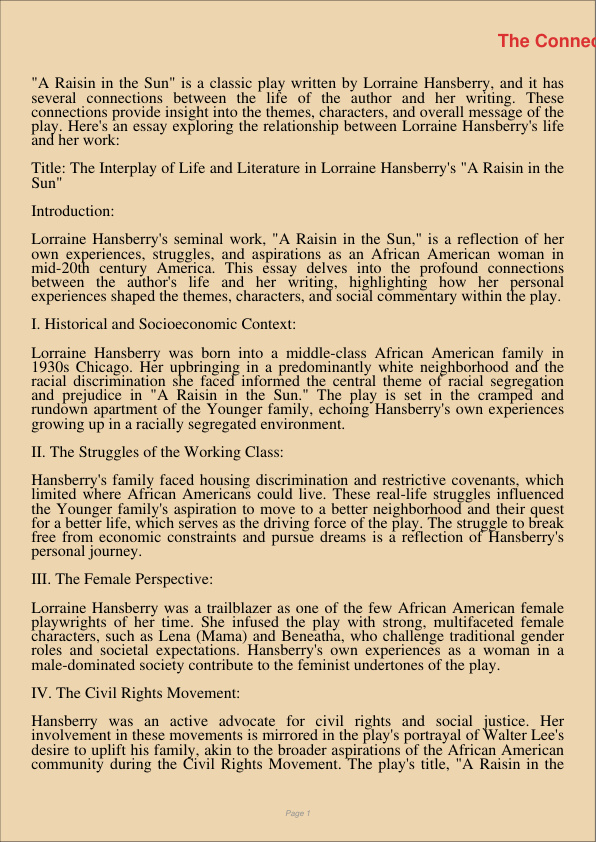The Connections Between The Life Of The Author And Her Writing In A Raisin In The Sun
Jan 8, 2024
writing
sun
Literature
History
“A Raisin in the Sun” is a classic play written by Lorraine Hansberry, and it has several connections between the life of the author and her writing. These connections provide insight into the themes, characters, and overall message of the play. Here’s an essay exploring the relationship between Lorraine Hansberry’s life and her work:
Title: The Interplay of Life and Literature in Lorraine Hansberry’s “A Raisin in the Sun”
Introduction:
Lorraine Hansberry’s seminal work, “A Raisin in the Sun,” is a reflection of her own experiences, struggles, and aspirations as an African American woman in mid-20th century America. This essay delves into the profound connections between the author’s life and her writing, highlighting how her personal experiences shaped the themes, characters, and social commentary within the play.
I. Historical and Socioeconomic Context:
Lorraine Hansberry was born into a middle-class African American family in 1930s Chicago. Her upbringing in a predominantly white neighborhood and the racial discrimination she faced informed the central theme of racial segregation and prejudice in “A Raisin in the Sun.” The play is set in the cramped and rundown apartment of the Younger family, echoing Hansberry’s own experiences growing up in a racially segregated environment.
II. The Struggles of the Working Class:
Hansberry’s family faced housing discrimination and restrictive covenants, which limited where African Americans could live. These real-life struggles influenced the Younger family’s aspiration to move to a better neighborhood and their quest for a better life, which serves as the driving force of the play. The struggle to break free from economic constraints and pursue dreams is a reflection of Hansberry’s personal journey.
III. The Female Perspective:
Lorraine Hansberry was a trailblazer as one of the few African American female playwrights of her time. She infused the play with strong, multifaceted female characters, such as Lena (Mama) and Beneatha, who challenge traditional gender roles and societal expectations. Hansberry’s own experiences as a woman in a male-dominated society contribute to the feminist undertones of the play.
IV. The Civil Rights Movement:
Hansberry was an active advocate for civil rights and social justice. Her involvement in these movements is mirrored in the play’s portrayal of Walter Lee’s desire to uplift his family, akin to the broader aspirations of the African American community during the Civil Rights Movement. The play’s title, “A Raisin in the Sun,” is drawn from Langston Hughes’ poem, “Harlem,” which conveys the idea that deferred dreams can fester and ultimately explode. This concept parallels the frustrations and ambitions of the Civil Rights era.
V. Personal Identity and Heritage:
The character of Beneatha, a young woman exploring her African heritage and identity, reflects Hansberry’s own interest in Pan-Africanism and the African diaspora. The play raises questions about the significance of heritage, identity, and self-discovery, drawing from Hansberry’s own intellectual and cultural pursuits.
Conclusion:
Lorraine Hansberry’s “A Raisin in the Sun” is not merely a work of fiction; it is a reflection of the author’s life, experiences, and convictions. Her personal encounters with racism, discrimination, and her fervent commitment to social justice are all woven into the fabric of the play. The characters and themes in “A Raisin in the Sun” resonate with authenticity, drawing from the author’s own life, making it a powerful and enduring piece of American literature that continues to inspire and provoke thought.
